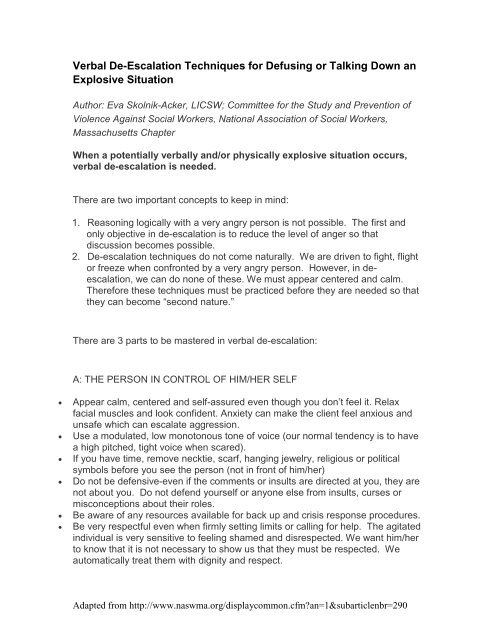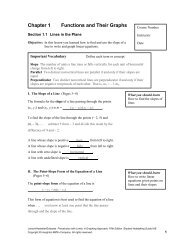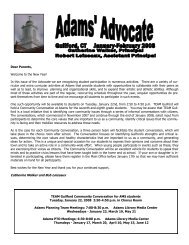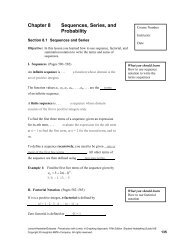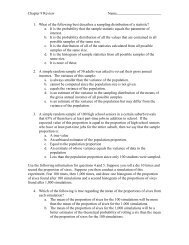Verbal De-Escalation Strategies & tips
Verbal De-Escalation Strategies & tips
Verbal De-Escalation Strategies & tips
You also want an ePaper? Increase the reach of your titles
YUMPU automatically turns print PDFs into web optimized ePapers that Google loves.
<strong>Verbal</strong> <strong>De</strong>-<strong>Escalation</strong> Techniques for <strong>De</strong>fusing or Talking Down an<br />
Explosive Situation<br />
Author: Eva Skolnik-Acker, LICSW; Committee for the Study and Prevention of<br />
Violence Against Social Workers, National Association of Social Workers,<br />
Massachusetts Chapter<br />
When a potentially verbally and/or physically explosive situation occurs,<br />
verbal de-escalation is needed.<br />
There are two important concepts to keep in mind:<br />
1. Reasoning logically with a very angry person is not possible. The first and<br />
only objective in de-escalation is to reduce the level of anger so that<br />
discussion becomes possible.<br />
2. <strong>De</strong>-escalation techniques do not come naturally. We are driven to fight, flight<br />
or freeze when confronted by a very angry person. However, in deescalation,<br />
we can do none of these. We must appear centered and calm.<br />
Therefore these techniques must be practiced before they are needed so that<br />
they can become “second nature.”<br />
There are 3 parts to be mastered in verbal de-escalation:<br />
A: THE PERSON IN CONTROL OF HIM/HER SELF<br />
• Appear calm, centered and self-assured even though you don’t feel it. Relax<br />
facial muscles and look confident. Anxiety can make the client feel anxious and<br />
unsafe which can escalate aggression.<br />
• Use a modulated, low monotonous tone of voice (our normal tendency is to have<br />
a high pitched, tight voice when scared).<br />
• If you have time, remove necktie, scarf, hanging jewelry, religious or political<br />
symbols before you see the person (not in front of him/her)<br />
• Do not be defensive-even if the comments or insults are directed at you, they are<br />
not about you. Do not defend yourself or anyone else from insults, curses or<br />
misconceptions about their roles.<br />
• Be aware of any resources available for back up and crisis response procedures.<br />
• Be very respectful even when firmly setting limits or calling for help. The agitated<br />
individual is very sensitive to feeling shamed and disrespected. We want him/her<br />
to know that it is not necessary to show us that they must be respected. We<br />
automatically treat them with dignity and respect.<br />
Adapted from http://www.naswma.org/displaycommon.cfm?an=1&subarticlenbr=290
B: THE PHYSICAL STANCE<br />
• Never turn your back for any reason<br />
• Always be at the same eye level. Encourage the person to be seated, but if<br />
he/she needs to stand, you stand up also.<br />
• Allow extra physical space between you – about four times your usual distance.<br />
Anger and agitation fill the extra space between you and the person.<br />
• Do not stand full front to person. Stand at an angle so you can sidestep away if<br />
needed.<br />
• Do not maintain constant eye contact. Allow the person to break his/her gaze<br />
and look away.<br />
• Do not point or shake your finger.<br />
• DO NOT smile. This could look like mockery or anxiety<br />
• Do not touch – even if some touching is generally culturally appropriate and<br />
usual in your setting. Very angry people may misinterpret physical contact as<br />
hostile or threatening.<br />
• Keep hands out of your pockets, up and available to protect yourself. It also<br />
demonstrates non-verbal ally.<br />
• Do not argue or try to convince, give choices i.e. empower.<br />
• Don’t be defensive or judgmental.<br />
C: THE DE-ESCALATION DISCUSSION<br />
• Remember that there is no content except trying to calmly bring the level of<br />
anger down to a safer place.<br />
• Do not get loud or try to yell over a screaming person. Wait until he/she takes a<br />
breath; then talk. Speak calmly at an average volume.<br />
• Respond selectively; answer all informational questions no matter how rudely<br />
asked, e.g. “Why do I have to do this g-d homework?” This is a real informationseeking<br />
question). DO NOT answer abusive questions (e.g. “Why are all<br />
teachers (an insult?) This question should get no response what so ever.<br />
• Explain limits and rules in an authoritative, firm, but always respectful tone. Give<br />
choices where possible in which both alternatives are safe ones (e.g. Would you<br />
like to continue our discussion calmly or would you prefer to stop now and talk<br />
tomorrow when things can be more relaxed?)<br />
• Empathize with feelings but not with the behavior (e.g. “I understand that you<br />
have every right to feel angry, but it is not okay for you to treat myself or others<br />
this way.)<br />
• Do not solicit how a person is feeling or interpret feelings in an analytic way.<br />
• Do not argue or try to convince.<br />
• Wherever possible, tap into the person’s thinking mode: DO NOT ask “Tell me<br />
how you feel. But: Help me to understand what your are saying to me” People<br />
are not attacking you while they are teaching you what they want you to know.<br />
Adapted from http://www.naswma.org/displaycommon.cfm?an=1&subarticlenbr=290
• Suggest alternative behaviors where appropriate e.g. “Would you like to take a<br />
break and have a cup of water?<br />
• Give the consequences of inappropriate behavior without threats or anger.<br />
• Represent external controls as institutional rather than personal.<br />
• Trust your instincts. If you assess or feel that de-escalation is not working,<br />
STOP! You will know within 2 or 3 minutes if it’s beginning to work. Seek help<br />
and follow crisis response plan.<br />
There is nothing magic about calming a very angry or agitated person. You are<br />
transferring your sense of genuine interest in what the person wants to tell you,<br />
of calmness, and of respectful, clear limit setting in the hope that the person<br />
actually wishes to respond positively to your respectful attention.<br />
Adapted from http://www.naswma.org/displaycommon.cfm?an=1&subarticlenbr=290


